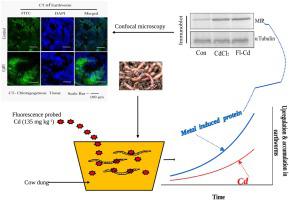Journal of Hazardous Materials ( IF 13.6 ) Pub Date : 2020-07-01 , DOI: 10.1016/j.jhazmat.2020.123357 Nazneen Hussain 1 , Subhendu Kumar Chatterjee 2 , Tushar Kanti Maiti 3 , Linee Goswami 4 , Subhasish Das 5 , Utsab Deb 6 , Satya Sundar Bhattacharya 7

|
Earthworms neutralize toxic metals by a small (∼13 kDa) cysteine rich metal binding protein, metallothionein (MT). Although the rate of metal accumulation and MT expression does not correlate well, the reason behind such inconsistency has not yet been deciphered. The present investigation clearly demonstrates that expression of some non-MT metal induced proteins is responsible for such incongruity. Applying selective protein isolation techniques in fluorescence tagged cadmium exposed (135 mg/kg) earthworms we were able to purify a 150 kDa metal induced protein (MIP) among others. After 60 days of exposure cadmium accumulation in earthworm intestines was significant. Immunofluorescence staining followed by confocal microscopy exhibited that MIP accumulates ingested cadmium in the intestinal region and eventually deposits the metal in the chloragogenous tissue. We determined the N-terminal sequence of 15 amino acid residues and after bioinformatics analysis, it was concluded that MIP is most probably a glutamic acid rich, novel cadmium binding protein. To further validate the binding mechanism, we conducted paper chromatography and continuous variation experiments which evidenced that cadmium readily binds to glutamic acid. The present finding is the first in-vivo evidence of a non-metallothionein cadmium binding protein induced in the intestines of earthworm exposed to a cadmium rich environment.
中文翻译:

induced中金属诱导的非金属硫蛋白:一种在氯致组织中镉解毒的新途径。
by通过一个小的(约13 kDa)富含半胱氨酸的金属结合蛋白金属硫蛋白(MT)来中和有毒金属。尽管金属积累的速率与MT的表达之间没有很好的相关性,但尚未弄清这种不一致的原因。本研究清楚地表明,某些非MT金属诱导的蛋白质的表达是造成这种不一致的原因。在荧光标记的暴露于镉的((135 mg / kg)中应用选择性蛋白分离技术,我们能够纯化出150 kDa的金属诱导蛋白(MIP)等。暴露60天后,worm在肠道中的镉积累显着。免疫荧光染色后再进行共聚焦显微镜检查显示,MIP会在肠道区域积累摄入的镉,并最终将金属沉积在绿藻组织中。我们确定了15个氨基酸残基的N端序列,经过生物信息学分析,得出的结论是MIP最有可能是富含谷氨酸的新型镉结合蛋白。为了进一步验证结合机理,我们进行了纸层析和连续变化实验,证明镉很容易与谷氨酸结合。目前的发现是第一个 我们进行了纸色谱和连续变化实验,证明镉很容易与谷氨酸结合。目前的发现是第一个 我们进行了纸色谱和连续变化实验,证明镉很容易与谷氨酸结合。目前的发现是第一个暴露于富镉环境的worm肠中诱导产生的非金属硫蛋白镉结合蛋白的体内证据。


























 京公网安备 11010802027423号
京公网安备 11010802027423号